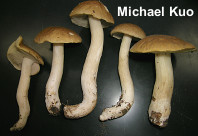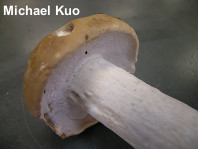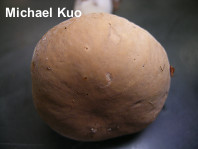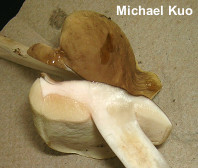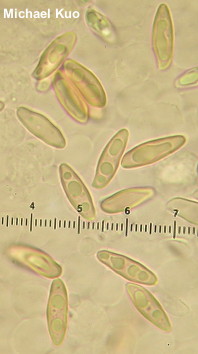| Major Groups > Boletes > Edulis Group > Boletus nobilis |

|
Boletus nobilis [ Basidiomycota > Boletales > Boletaceae > Boletus . . . ] by Michael Kuo This is a distinctive, hardwood-associated bolete from the Appalachian Mountains, recognized by its pore surface, which is "stuffed" and white when young, its finely lined or faintly reticulate stem, its yellow-brown cap, and its stature: the stem is relatively narrow, and often two or three times as long as the cap is wide. It is a member of the Boletus edulis group—which is another way of saying that it is a true species of Boletus in the contemporary sense of the genus. But while the mushroom is distinct enough, its name may be a problem; whether or not this species should really be called "Boletus nobilis" is an issue that needs to be settled. Peck's original, 1905 description of the species calls for a cap that is "yellowish brown or reddish brown when young, becoming ochraceous with age," tubes that become "yellow or pale ochraceous," and a stem that is "generally reticulated at the top." These specifications do not really match the mushroom that has been recently popularized in field guides (Bessette and collaborators, 2000; Roody, 2003; Binion and collaborators, 2008) as "Boletus nobilis" and which is described here; it is never reddish brown and only occasionally finely reticulate at the extreme apex of the stem. Additionally, Peck's proportions (cap "4–8 inches broad" and stem "3–6 inches long") do not match. The naming question is complicated further by the fact that several North American mycologists appear to have mistaken Boletus nobilis for other things. Snell and Dick (1970), for example, appear to have misidentified old Boletus separans specimens as Boletus nobilis, while Smith & Thiers (1971) mistakenly thought Boletus nobilis was synonymous with Boletus separans. Singer (1947) at first thought Boletus nobilis was a synonym of the classic European species Boletus aereus, but later (1977) decided that it was indeed a separate species--the one described by Smith & Thiers as "Boletus separans." Halling (1998) summarized this taxonomic milieu and clarified Boletus separans admirably--but did not focus on what, exactly, Boletus nobilis should be. Description: Ecology: Mycorrhizal with oaks and possibly with other hardwoods; growing alone or gregariously; summer and fall; distributed in the Appalachian Mountains. The illustrated and described collections are from West Virginia and Ohio. Cap: 5–8 cm across; convex, becoming broadly convex; tacky or dry; glabrous; yellow-brown; becoming a little pitted and rugged with age. Pore Surface: At first white and "stuffed"; becoming yellowish and eventually olive yellow; not bruising; with 2–3 round pores per mm; tubes to 12 mm deep. Stem: 7–15 cm long; 1.5–2.5 cm thick; equal, or slightly enlarged downward; often curved near the base; smooth or, often, very finely and shallowly longitudinally ridged; usually not reticulate but occasionally finely so at the apex; bald; whitish to brownish; basal mycelium white. Flesh: White, or faintly yellowish in the stem apex; not changing when sliced. Odor and Taste: Not distinctive. Chemical Reactions: Ammonia negative on cap surface; pinkish on flesh. KOH negative on cap surface; negative on flesh. Iron salts negative on cap surface; negative on flesh. Spore Print: Not documented. Microscopic Features: Spores 14–16 x 4–4.5 µm; narrowly fusiform; smooth; yellowish in KOH. Hymenial cystidia to 50 x 12.5 µm; lageniform; thin-walled; hyaline in KOH. Pileipellis a collapsing trichoderm of elements 5–10 µm wide; slightly gelatinized in places; hyaline in KOH; terminal cells cylindric, often short-septate and clavate to apically pinched. REFERENCES: Peck, 1905. (Both, 1993; Halling, 1998; Bessette et al., 2000; Roody, 2003; Binion et al., 2008.) Herb. Kuo 07291202. This site contains no information about the edibility or toxicity of mushrooms. |
© MushroomExpert.Com |
|
Cite this page as: Kuo, M. (2016, August). Boletus nobilis. Retrieved from the MushroomExpert.Com Web site: http://www.mushroomexpert.com/boletus_nobilis.html |
